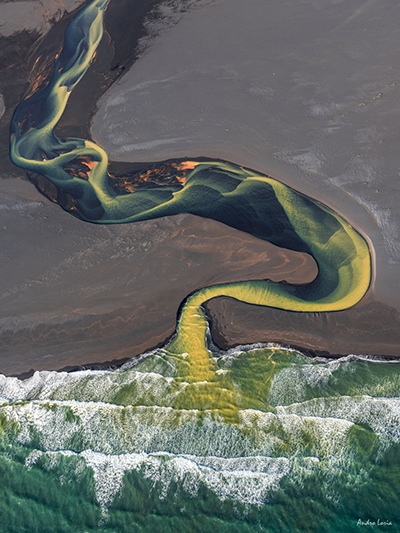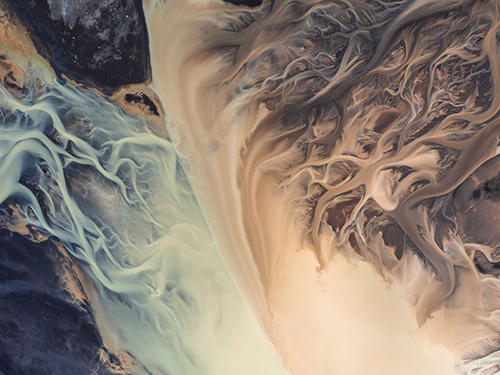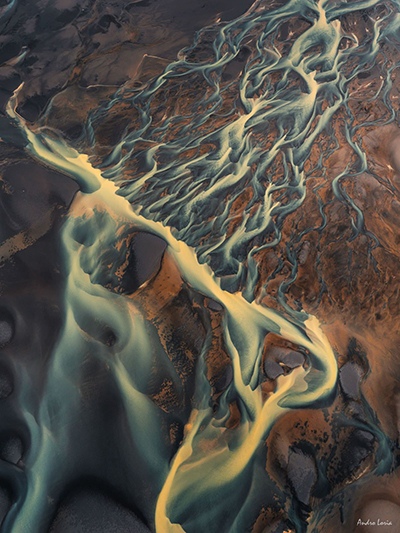Vibes of Nature Revealed by Andro Loria
The sprawling river networks, reminiscent of vascularization, that spread out in the Icelandic terrain are utterly breathtaking. The colors, shapes and patterns are beautifully interwoven and contrasted, making for glorious naturally created visual presentations. Owing to Andro′s talents in capturing images of these amazing landscapes, as well as his effort in conquering the skill of taking photos from airplanes, people are able to glimpse these spectacular natural wonders deep in the magical Icelandic realm. But that′s not the only breathtaking photograph series Andro has created – another series shows the icebergs of Greenland or the impressionistic effects of rain on windows in the cityscape of London. Whether traveling far or staying close to home, Andro captures what people usually don′t see, showing us the vibrant and colorful world that we live in (IG @andro_loria).
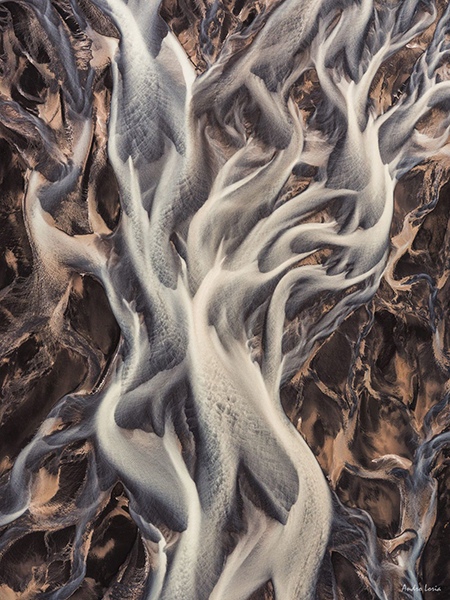
Andro is a scientist who began his photography journey a few years ago. He likes to photograph Iceland and Greenland, places on Earth that are still relatively untouched. Because of his dedication and talent in capturing these beautiful landscapes, his photos have been featured by National Geographic, Smithsonian, The Times and other major publishers according to his website: http://androloria.com/
We are so excited to have the opportunity to speak with Andro and learn about his passion for photography. We are also eager to learn the steps he has taken to capture such beautiful and captivating photos. We hope you enjoy the following interview:
Q: Your photography is absolutely stunning. Some of them are abstract and almost organic in appearance. Please share with us your background in photography and whether you received any formal artistic training before taking up photography.
A: Thank you very much Adelina, you are so kind and thank you very much for inviting me. I did not have any formal training or education in art or photography. I prefer learning by myself on my own terms, probably, at least in part, due to my main job being a scientist. My photography started a few years ago when I wanted a creative outlet completely outside of my main job, which is a university science professor. The job provides many challenges and I′ve definitely benefited from working with computer-based image analysis, all sorts of microscopy, building 3D structures of important biological proteins and complexes and having decades of film (x-ray mostly) developing in the lab. I guess I also benefit from constantly trying to see things differently and from other angles, decades of combining observation with intuition; photography allows me to switch my daily ″analytical mode″ off, so my shots are mostly intuitive and pretty much come from the way I see/feel things.
Q: The aerial photos of Iceland are breathtaking. Some of the river photos look like vasculature. Please share with us how you took these photos in terms of the location, altitude, and equipment.
A: Yes, those views from above in Iceland are like views of a different planet and often have this other-worldly feeling about them. Sometimes they indeed look like a vascular system of sorts – nature repeats its patterns – and sometimes like a giant neuronal network laid out on the ground. Photographing those views is both a challenge and an immense pleasure and privilege. Playing with light and composing from a fast moving airplane is great fun, and even when we take a few fly-overs over a specific area it never looks the same, as light and shadows move and so does the angle of the shot(s).
In the last two – three years my focus has mostly been on aerial photography, though during my first few visits to Iceland I was photographing on the ground. However, from my days in mountain trekking and hiking I knew that the view from the top is unbeatable. I was lucky to meet a wonderful pilot who is also an excellent photographer and a great friend – Haraldur Diego (@volcanopilot) and flying with him completely ruined ground shots for me 🙂
The uniqueness of views, ever changing patterns of landscape and light, fast changing scenery all make aerial photography very challenging but also very rewarding.
One can do aerial photography from either helicopters or small airplanes and even with drones, though the latter are way behind in terms of camera and sensor quality. I personally prefer small planes for the feeling of flight. A typical flight could be between three to six hours long depending on location and weather and photographs are taken mainly between 1,000 and 3,000 ft altitude. To get a straight down shot the aircraft has to bank (sharp turn) so you face the place of interest without any obstructions. It is an odd feeling at first and often turbulence adds to the experience, but one gets used to it. I tend to get my head, shoulder and camera holding ″shutter″ arm out of the window, with my other hand controlling the aperture and zoom – I use wonderful Fujifilm cameras with dials and lenses that have aperture rings. Sometimes I lean out of the window to take a shot straight ahead or back. I do not use the LCD screen on the back of my cameras due to reflection, so I shoot with my eye to the viewfinder.
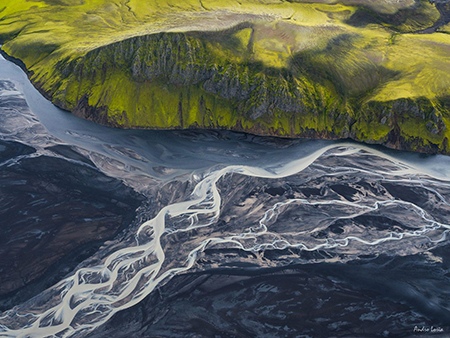
The most important thing in the air is the communication with your pilot. The choice of location comes from planning of course, but often, especially due to Icelandic weather, the plans change on the spot or get cancelled completely. Generally, I have an area of interest and a few favourite locations which can be covered in a few hours of flight. Iceland is unique, as it has a great variety of landscape types within a relatively short range of distance. You can have deserts, volcanos, glaciers, mountains, braided rivers and lakes, sea coast and highlands all in one flight. It is like a continent in miniature. An what an amazing ″continent″ it is.
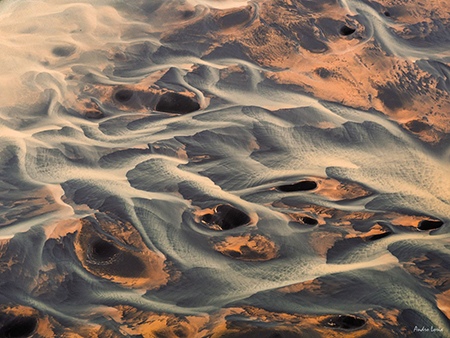
For equipment – I typically have two identical camera bodies with me – GFX50S with a short zoom lens like 32-64mm (23-50 in FF) or 45-100mm (35-85mm in FF) as a main camera with a battery grip and a second back-up body with either long zoom 100-200mm (70-140 in FF) or a bright prime 63mm f2.8 (50mm in FF). I have plenty of spare SD cards and batteries in easy to access pockets to change in the plane when I have a chance. The airplane we fly in Iceland is a wonderful Cessna 172.
Q: You have also gone to Greenland to shoot the icebergs; one time you took a sailboat there. Please share with us this unique experience and what you came away with from this journey.
A: I love the Arctic, as I grew up in cold snowy winters, so getting back to the North is always a homecoming for me. My first trip to Greenland was in 2014 trekking in the mountains, I had a sailing trip in 2017 and more recently as I love dogs and snowy winters, I had a dog sledding trip in 2019. I hope my next trip(s) will be to do some aerial photography at both Eastern and Western parts of this amazing continent-sized island.
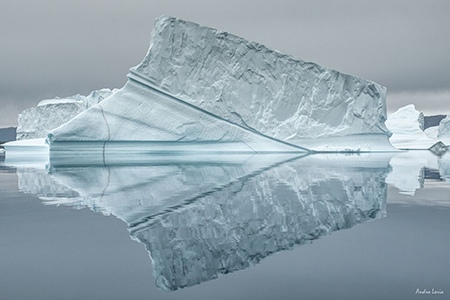
As for the sailing trip – sailing between icebergs in the massive fjord of East Greenland is like being on another planet. You see epic scenery but also witness the fragility of nature. Sadly, due to climate change, the latter becomes more and more of an issue when I travel in the North. It makes you think sometimes that the shot you made could probably be the last shot of a glacier in its full power and size. One of my friends said that Greenland and especially East Greenland is the last place where you can have an unplanned adventure and it certainly was a wonderful trip both adventure and photography-wise.
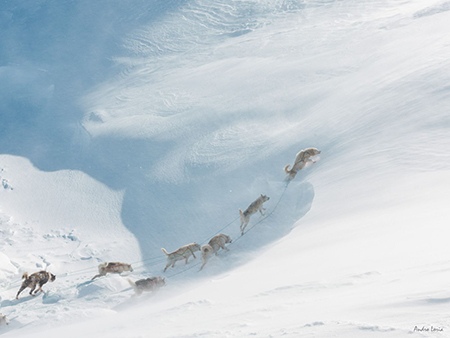
Q: What are you looking for when you take a shot? The atmosphere, geological formation, something else?
A: I think all of those things are important and always interweave in my mind. Sometimes I have an idea of an area and what I would ideally love to see there but have to wait for a long time and many flights to see the elements clicking together. It is pretty much about my mood and my feeling when I see something. If I react to it – that is ″my type″ of scenery. As an example – during the last year′s dog-sledding trip in East Greenland we were sledding in mountains, it was late, really cold with a very strong wind, at some point we got over a ridge and this amazing view opened up with a frozen small plateau and path through the mountains all lit by a low sunset. By that time, we were probably 3-4 hours on a road and my hands and my camera started to freeze (it was about -25C or lower plus wind) but the scenery was so moving that I just had to stand up on sled, which at that point started to move fast downhill, with one hand on sled and one with camera trying to grab a few shots. One of those captures is one of my most favorite shots I have from Greenland.
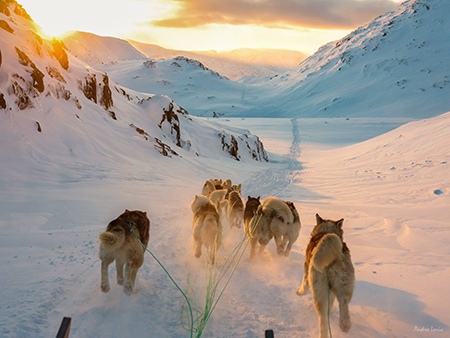
Another example – during last year′s summer flight, we were exploring the edge of the largest ice cap in Iceland – Vatnajökull – we came across an amazing merging of differently coloured glacial streams, the ones which looked very vascular. On its own it was already out of this world and we shot it for some time from different angles and were ready to move on when we saw some birds flying into this area. One of the following shots with three lined up birds over that area is probably when everything just came together.
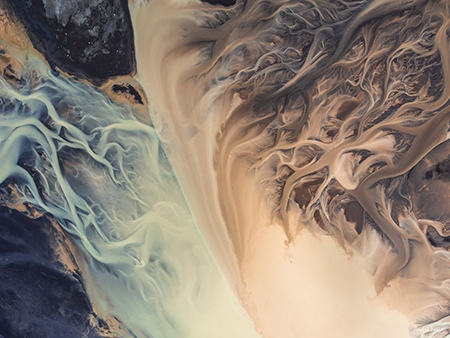
Q: Besides Iceland and Greenland, is there any other place that you like to shoot photos and why?
A: I think it is more what I love to shoot and what is close to my heart. Both Iceland and Greenland are on the top of my list, but so is London with its amazing street scenery, lights and countless reflections on water and windows, especially on a rainy winter night. I keep travelling so I may find new places I will fall in love with and shoot them too. I will certainly try other Nordic countries and places in the Arctic and would love to go South too and visit a few specific locations in Africa and South America for aerial photography, but the list does not stop there. We live on a beautiful planet and there are so many amazing places one can fly over and photograph.
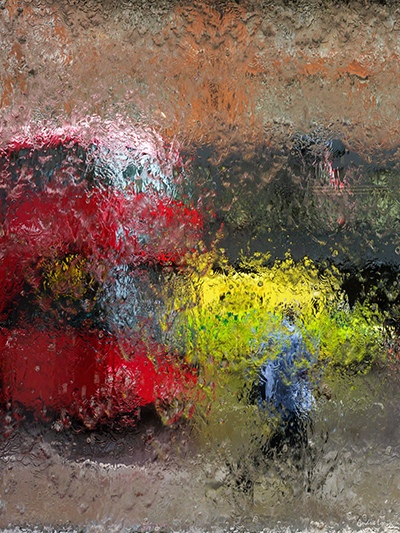
Q: You have taken a series called ″Waterworld″ with a GFX50S (a medium format, mirrorless camera) which produced the most amazing impressionistic effects. Please share with us this experience and how GFX50S helps you to achieve this effect.
A: The idea of the ″Waterworld″ series came about first when I was on a London bus during rain. I loved how impressionistic everything looked when a layer of streaming water stripped most details leaving just enough to make up the scenery in your mind. But shooting from a moving bus would be difficult (vibration, window reflection etc). However, when I discovered that one of the nearby office buildings has a large clean crystal glass window with a built-in waterfall feature I started shooting the series. It is an ongoing ″project″ so every year I add new images to it.
I think the main effect of those images comes from the running water and the camera with its sensor and great lens helped to capture that. I am somewhat biased towards Fujifilm cameras with their dials on the camera and aperture ring on the lenses that allow me to work very fast without using any camera menus. It is a mirrorless camera, so I see what I will get in the EVF and by using different film simulations and the histogram I can very quickly adjust my settings. The camera (and its sensor) gives me fantastic results with superb 50Mpx files having 14-15 stops of DR, the pixel pitch is large, which is better for low light and great for printing.
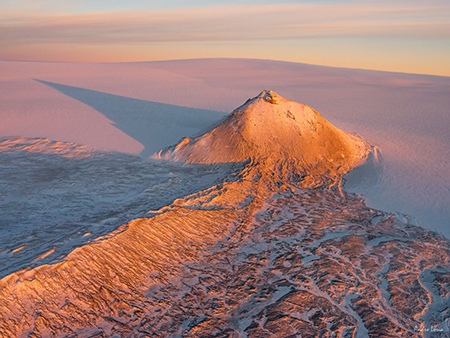
Q: What is the major difference between taking a shot on the ground and from the plane, specifically the depth of field and other major issues?
A: When shooting in the air, depth of field is less important as the distance between photographer and the area of interest is rather large. When taking a shot straight down one can shoot wide open, as the target area would all be in the same focal plane. This is very helpful when light is poor. Generally I would try to use a sweet spot of the lens′s optical ability that is one or two stops down to get the best of the image. If you are interested in exif data you can find them for images I post on 1x.com gallery so you can get a good idea of camera settings in different situations. The main difference is time – you have ample amount of it to take shots on the ground, even if you use filters, tripods etc. You have seconds or less to react and take a shot when in the air, so you constantly stay alert, as scenery changes very fast.
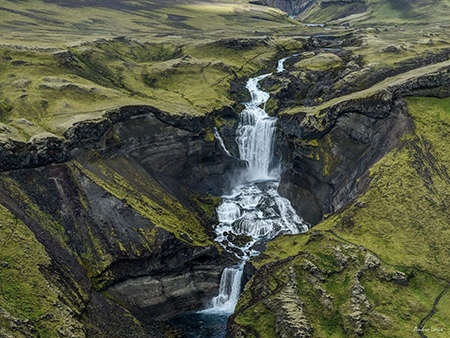
Q: There are so many choices of cameras in the market, for a beginner who wants to shoot landscape photos, the choices could be overwhelming. Do you have any suggestions as to the choices for a beginner and the migration to a more complicated camera?
A: I think it is a personal decision about which camera suits you and it is not as important as many people think, just as no one would think which typewriter is best for writing novels or poetry. A camera is a recording device and of course the lens that you use will allow you to capture scenery wide or close depending on what you like. There are many web forums and sites, which can help one to choose their first photo gear. I learned photography with cropped sensor Fujifilm cameras because I like their small size and light weight, old school ergonomics and controls, great film-like sensors and great lenses. This is more than enough for travel, social media posting, small prints etc. When I wanted to start printing large sizes I moved to medium format cameras, which are larger, heavier and a lot more expensive, but give me insane image quality.
Q: Do you use any software for photo editing? If yes, what is it?
A: I edit my images with Capture One software. I also use it to prepare my images for prints.
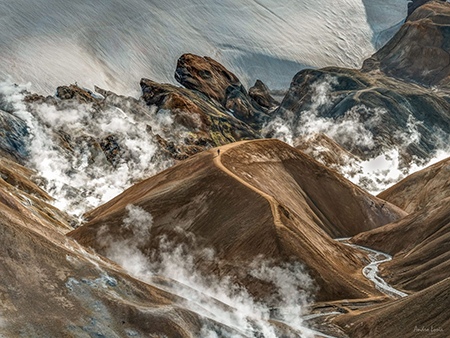
Q: For young enthusiastic photographers, do you have any suggestions or recommendations?
A: I am often asked what camera would I recommend, and I typically answer: whichever is best in your hands and whichever is the most fun to shoot. Do go out and shoot as often as possible – I still have a smaller rangefinder type camera in my everyday bag. Shoot everything – portrait, animals, architecture, nature, food, friends at parties – do not worry about what is the best subject for you, it will reveal itself. One day you will know what you love shooting most because you will have the best/closest emotional link with the subject and the images. And you will improve even more when you will eventually start focusing on what you love and value most.
Do not let lack of social media attention discourage you and do not try to copy others to become popular. You will become just another copy and not an original that people would want to see. Let your inner-self come out in your photography and you will be a happy photographer. All your experiences will come together. My work in science helped me to see and/or spot a difference and probably see my way better in 3D, street photography taught me to keep my eyes and mind open all the time and predict when I can get a ″perfect composition″ shot of moving subjects – something that came handy when shooting my friends′ weddings and of course later for aerials. Shooting aerials was also helped by learning the ropes of landscape shooting with tripods and filters – teaching me a lot of patience. Do not worry about which label you get associated with, photography is an art of its own, smaller divisions are less important. Do not try to stick to tradition or certain ″rules″ all the time. Learn the rules and then break them – try your own way, whether it is using a short prime for portraits or long lens for landscapes. Cameras and lenses are only tools to help you see and capture images the way you are most interested in.
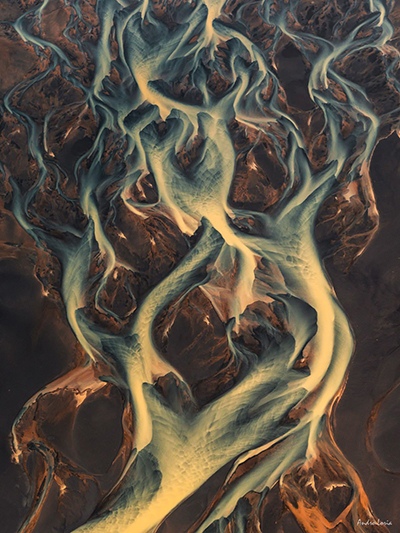
Q: Do you have any current or future projects that you would like to share with our readers?
A: I think I have now moved away from the concept of projects per se, I am just trying to shoot what I feel happy about and am interested in, sometimes it is a single shot in a month and sometimes there are a few thousand. It is more likely that the word project comes up when I go through my images and think if there is a way to group them. I think aerial photography is so immense that it will keep me busy and happy for years to come. So, the projects would mainly be about new areas to visit and photograph or shooting an old place in a new way. I do miss black and white architectural photography though, so when the pandemic is over, I will try to do more of it and I would also love to shoot people′s portraits in natural light, also in black and white, probably with some adapted legacy lenses, and of course there are multiple exposures to try in London… As Saul Leiter said ″I don′t have a philosophy. I have a camera″ meaning that everything is worth photographing. Or, maybe that is my philosophy after all.
We thank Andro for his candid and detailed explanation about the journey that he took to become an outstanding photographer. We hope we will be able to see more exciting photos from him soon.
